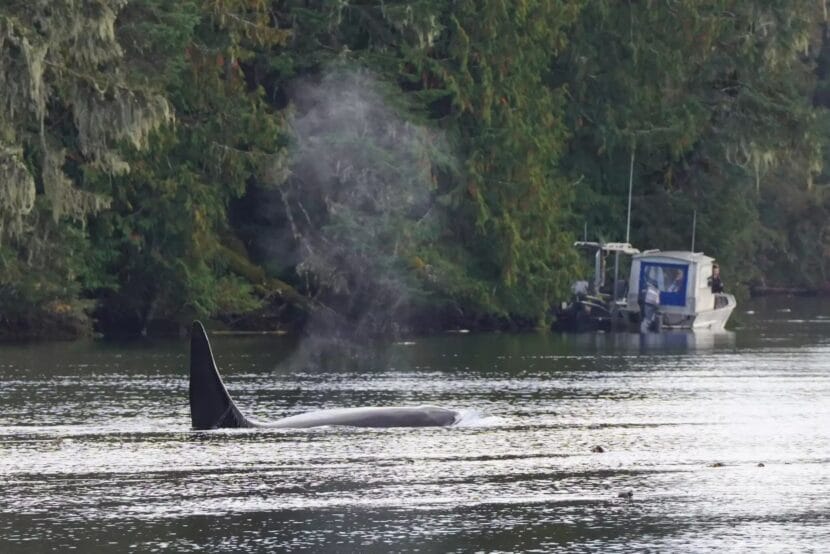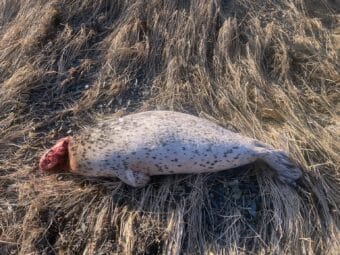
Late this summer, two killer whales swam into an ocean-fed lake on Prince of Wales Island and got trapped. The effort to free the whales took a collaboration between scientists and residents of the remote island town of Coffman Cove — with some extra help from the whales’ friends.
It’s possible to get into Barnes Lake from the ocean, but only at high tide, in a small boat.
Doug Rhodes lives around the corner in Coffman Cove, an ex-logging town with a winter population of around 100 people. He says those entrances are the only way to get to the lake, and they’re only passable by small boats at high tide.
“The north entrance is like a class four rapids at maybe two hours after the tide, and the south entrance is a waterfall,” Rhodes said.
So it was a bit of a surprise when two killer whales found their way into the lake in mid-August. Rhodes says at first, people were more curious than concerned.
“It was kind of a novelty thing, you know, ‘There’s whales in Barnes Lake!’ Everybody just figured they’d get out on their own,” he said.
But the window around high tide is short, and the entrances to the lake are small. The whales didn’t get out on their own. After a couple of weeks, folks in Coffman Cove called the experts.
Mandy Keough from the National Oceanic and Atmospheric Administration whale stranding hotline gathered a group of researchers and scientists with experience in orca live strandings. They were concerned about the whale’s body condition. The lake is freshwater fed, so it’s less salty than the ocean, and orcas need salt water to survive.
Jared Towers is a killer whale specialist with Fisheries and Oceans Canada. He says he knew it was possible the whales could get out on their own, but there was another possibility.
“They end up dying in there,” he said. “And dying a slow death because they’re basically starving to death.”
That’s because these were Bigg’s, or transient, killer whales. They eat mammals, not fish. Barnes Lake is full of salmon, but not many seals and sea lions.
The response team decided that their best chance of getting the whales out was during the big tides in late September, a few weeks away.
They would need boats on the lake — more than a dozen. And the researchers said they needed at least three people in each boat. That meant nearly half the town would be out on the lake. Rhodes says that wasn’t a problem.
“As it went on the energy level in town kept building, and more and more people wanted to get involved,” he said.
They would use nets in the water, which the whales experience as a barrier. And they would herd the whales using sound — by submerging metal pipes in the lake and banging on the exposed end. Each required special equipment, which the volunteers made with what the had around town.
The townspeople kept the scientists updated on the whale’s health with photos. From the photos, Towers was able to identify the whales as T051, a 42-year-old male, and T049A2, a 16-year-old male. Towers even knew which orcas they’d traveled with in the past. Not only that, he had actual recordings of those travel partners. The recordings could be played under water to lure the stranded whales toward the sound, a technique called “playback.”
Chloe Kotik studies Bigg’s killer whales for her doctorate degree at the University of Alaska Fairbanks. She says the barrier nets and sounds of metal pipes are stressful to whales. She says playbacks can be really effective, but they’re also stressful.
“When you play a recording of a killer whale that isn’t really there, for them, it’s like seeing a ghost,” Kotik said.
Kotik and Towers arrived with two other scientists a few days before the high tides. More than six weeks after the whales were spotted, 14 small boats filed into Barnes Lake.
Towers and Kotik started the playbacks, luring the whales toward the north channel. Volunteers in the boats banged the submerged pipes to urge them on.
At first, it seemed to be working. The whales responded to the playbacks by breaching and slapping the water with their tales. They followed the sound and entered the north channel. The boats lowered nets to keep the whales from turning back. But a thick kelp bed was blocking the entrance to the channel.
Time was short — the tide was going out. Towers says they knew it was their only shot that day.
“If that whale and the other one didn’t make it through the kelp, our window was over,” he said.
Then the bigger whale turned and swam back into the lake, ignoring the nets and sounds of the pipes. The younger whale was close behind. Towers says even the boats were in danger of getting stranded in the lake. Rapids were forming in the channel.
“We just radioed the others and said, you know, our time’s up,” he said.
Kotik says based on the weather forecast, they likely only had one more day to get the whales out. But more than that, she was worried that they’d already asked too much of the volunteers.
“These people in Coffman Cove have already given us so much of their time and their energy and their help,” she said. “And we didn’t get them out today, how much can we really ask them, and are they going to be willing to help us out with this?”
But when they got to the dock at Coffman Cove, the volunteers were waiting, ready to make plans for the next day.
“It was such a weight off of my shoulders to realize like oh my god, they’re still in it with us,” she said. “They haven’t lost faith in us. They haven’t lost hope.”
The next day they started at the south entrance, which was free of kelp. This time, when the whales heard the playbacks, they were all business. Rhodes and Fecko were in a boat with nets.
“And so they got out in the middle and played this playback, and we looked up and we see the whales coming towards us, and they were picking up speed as he was playing the whale sounds,” Rhodes said.
“There was a bow wake in front of these whales, they were just bookin’ it!” laughed Fecko.
As they charged toward the playback of their friends, the whales called out. The scientists’ underwater microphone picked up the sounds.
“We were just standing there hearing whale sounds across the water as they came by and, oh geez, there were people whooping and hollering and cheering, there were people crying out there.”
As they neared the southern entrance, one the whales dove deep.
They had to wait to deploy the nets until they were both past and in the channel.
They got the net out behind the whales. But Rhodes said it hardly seemed necessary.
“At that point, those guys were probably going ten knots. They didn’t think twice, they just busted right on out of there,” said Rhodes.
The playback boat led the whales through the channel. The southern entrance is long and winding and rocky. Towers said it took 10 to 15 minutes to pass through.
“I was holding my breath for a long time,” he said. “I told myself, ‘Okay when they’re past the maple tree we’re good,’ because there’s this beautiful big Canadian maple on the shoreline at the beginning of the south channel.”
They passed the maple. They kept swimming, out into Lake Bay, and then beyond. The boat followed them for a couple hours.
Kotik says they weren’t sure how the pair would adjust to their freedom.
“Then we saw a kind of shift into this much more quiet, purposeful swim,” she said. “And I think it was because they were starting to hunt. And that moment of seeing that shift was such a relief of like, ‘I really do think they’re going to be okay.’”
Towers and Kotik skiffed back to Coffman Cove. They found a celebration in full swing. Doug Rhodes and Cheryl Fecko said the local bar got plenty of business that night.
“You couldn’t you couldn’t hear in that bar. Everybody was just chattering away,” said Fecko.
“The bar was hopping, everybody was in there. I don’t know if the scientists bought a drink that night at all,” laughed Rhodes.
Scientists don’t know where the pair is now, but they will be spotted eventually. Researchers keep tabs on killer whales through photos sent in by scientists and civilians.



